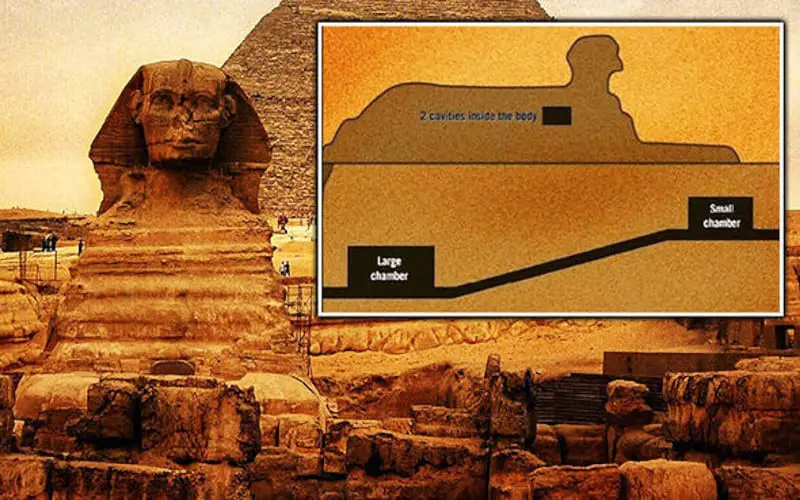Alongside the pyramids at the heart of the Giza Plateau in Egypt, the Sphinx has been quietly keeping watch for thousands of years.
Carved directly out of the bedrock, the sphinx’s true age is difficult to carbon date the age.
The Sphinx is a magnificent creature, part man, part lion, and it’s construction is a testament to our ancestors’ abilities and imagination.
The age and construction of the Sphinx is one thing, —but it’s the secrets that it guards that is the subject of this article.
It’s been long rumored that the “Hall of Records”, which is thought to contain worldly secrets and knowledge about the universe, is located underneath the Great Sphinx.
In this article we’ll explore the latest science behind what’s been found so far, what experts think, and whether the Hall of records could still be sitting untouched underneath the sphinx.
The Sphinx: A Brief History
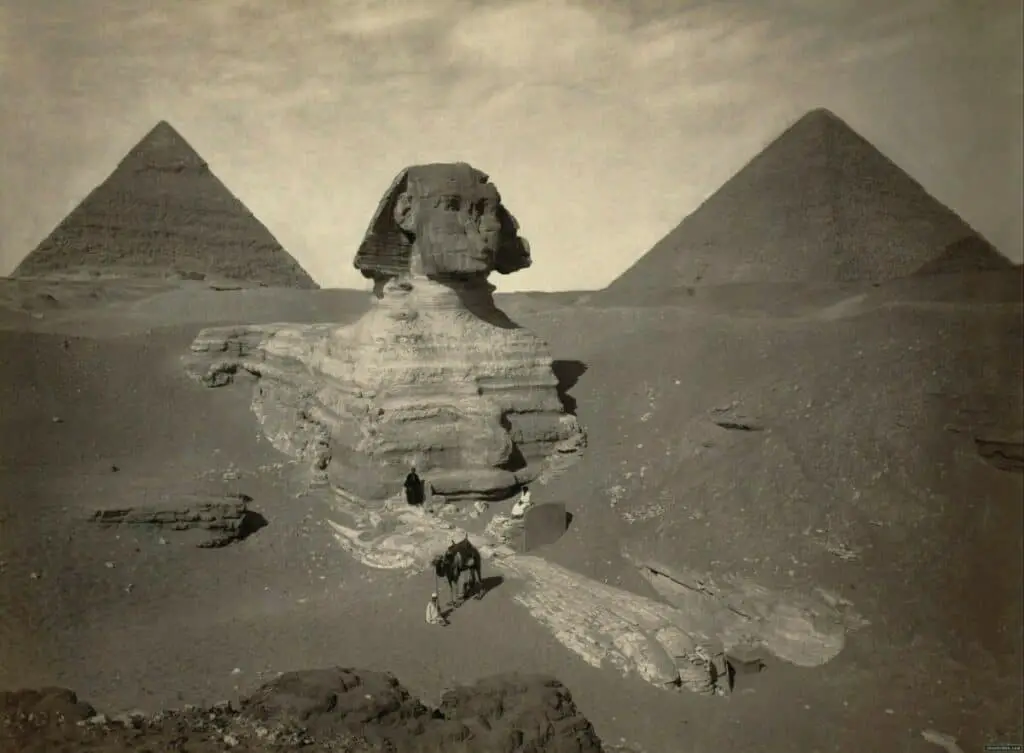
The ancient Sphinx is traditionally thought to have been carved around 2,500 BC from a single rock. However, this long-held belief is now being questioned due to new interpretations of the Sphinx’s erosion patterns.
Some scientists, including Geologist Dr. Robert M. Schoch, suggest these patterns could be due to water damage, implying that the Sphinx might be a stunning 10,000 years old – a revelation that could reframe our historical narrative. This view challenges the conventional belief held by Egyptologists who link the Sphinx’s creation to Pharaoh Khafre based on archaeological evidence and the statue’s resemblance to him.
According to egptologists from the Smithsonian magazine, the Sphinx originally had a different head, likely that of a lion. There is even speculation that the Sphinx’s alignment with the constellation Leo suggests a more ancient origin.
The debate between archaeology, favoring Khafre’s era around 4,500 years ago, and geology/astrology, pointing to a much older date around 12,000 BC, continues.
Known Shafts and Holes Around The Sphinx
1. The Osiris Shaft
The Osiris Shaft is not directly tied to the Sphinx. It’s located on the causeway the connects the sphinx to the second tallest Great Pyramid of Khafre.
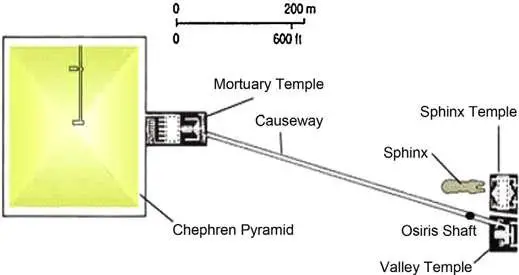
The Osiris shaft is a multi-level underground structure, also known as the “Giza Shaft,”. It’s like a rabbit hole dug right into the bedrock, plunging about 30 meters (about 98 feet) down.
You enter on the first level via a staircase you’ll find six burial slots carved into the walls. Although no human remains have ever been found.
A snug passage leads down on the second level into an empty chamber.
On the third level there’s a big chamber featuring an enormous sarcophagus cut from a single piece of Aswan granite. The sarcophagus was found empty.
Also, scattered around this level are four “pillars,” believed to symbolically represent the four children of Horus.
The Osiris Shaft was actually discovered as early as 1933–34 by famed Egyptologist, Dr. Selim Hassan. He labelled it “the most extraordinary example of this type of tomb hole”.
However, much of what we know about the Osiris Shaft today is thanks to the tireless work of archaeologist Zahi Hawass and his team. In the late ’90s and early 2000s, they dug deep into the Osiris shaft.
Many believe that the Osiris Shaft is the same subterranean complex that corresponds to the structure described by the ancient Greek historian Herodotus during his visit to the Great Sphinx in the 5th century BC.
2. Perring’s Hole
“Perring’s Hole” is not a chamber, but a large crater located behind the head of Great Sphinx of Giza. It’s named after John Shae Perring, a 19th-century engineer who, with his buddy, British archeologist Colonel Richard William Howard Vyse created the hole when their drill rods got stuck.
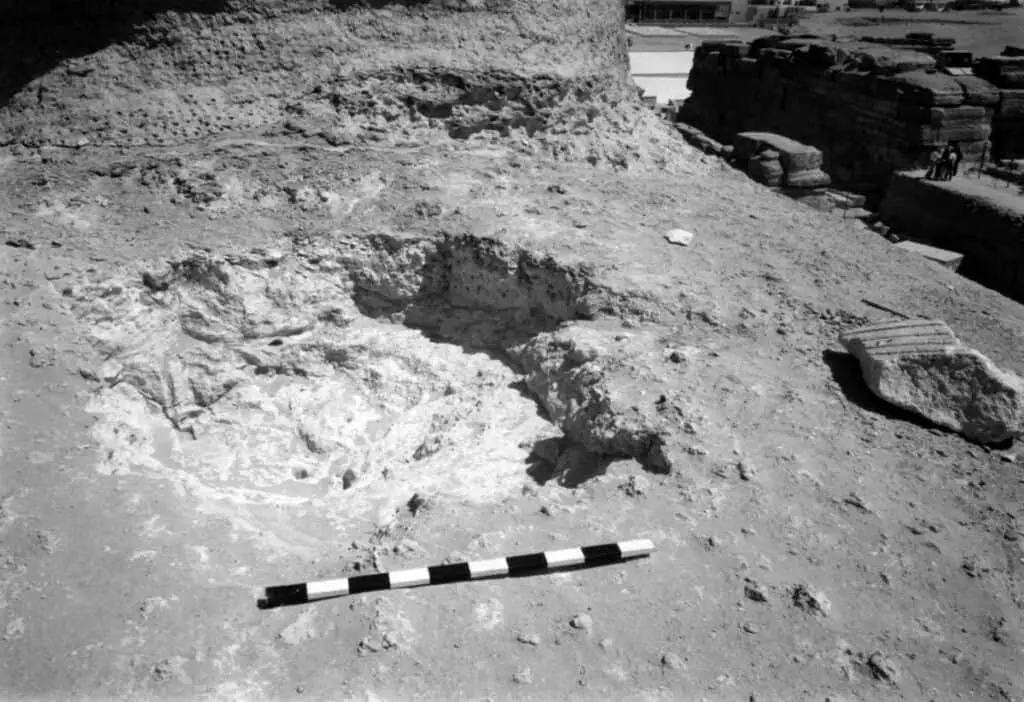
Howard Vyse directed Perring in 1837 to drill a tunnel in the back of the Sphinx, just behind the head. The boring rods became stuck at a depth of 27 feet (8.2 m). Attempts to blast the rods free caused the damage seen today.
The hole was later cleared of debris in 1978 by Dr. Zahwi Hawass and among the rubble was a fragment of the Sphinx’s original headdress
3. The Eastern Shaft
The “Eastern shaft” is tucked between the mighty paws of the Sphinx. It’s a rectangular pit and it’s not believed to lead anywhere or connect to any underground tunnel. There’s a not a lot of information available about the Eastern Pit. It seems as though it’s just a hole currently sealed with an iron trap door, a step taken during restoration work in the 1920s.
Emile Baraize, a French engineer, lead the restoration efforts in the 1920’s. Part of his plan was to secure the pit with a cement roof and an iron beam, then top it off with that trap door. These measures were all about preserving the Sphinx for future generations.
But we don’t really know much about this shaft. Why was it there? What was its original purpose?
4. “Shaft A”
“Shaft A” is a actually a deep hole on top of the Sphinx’s head leading nowhere.
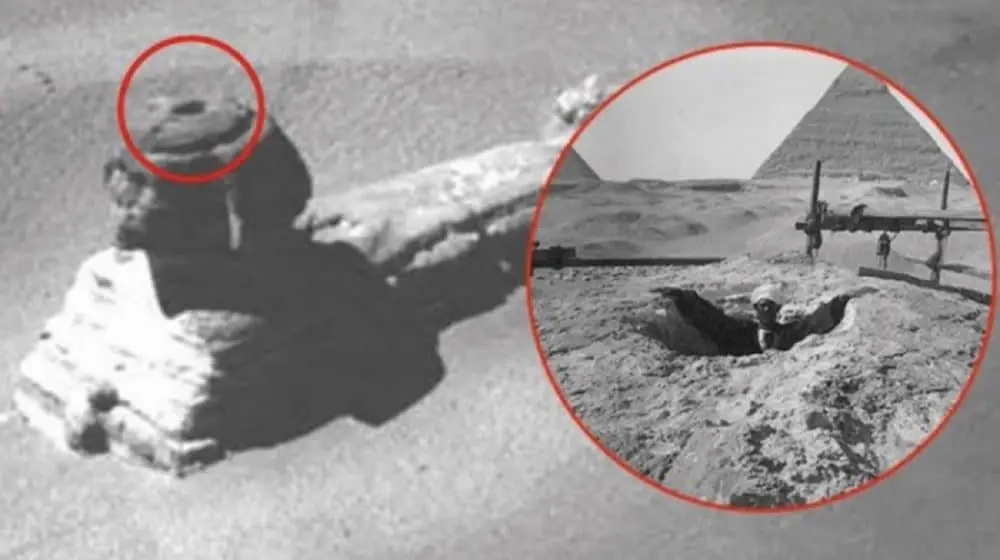
Back in the 1920’s, Emile Baraize covered it with cement and topped it with an iron trapdoor as part of his restoration efforts. This hole is about 5 feet square and nearly 6 feet deep.
It is unknown why the hole is there in the first place. Some believe the pit was originally part of a support system for the ancient headdress to the Sphinx.
Back in 1798, French Archeologist Vivant Denon, who had joined Napoleon’s expedition to Egypt, sketched the Sphinx showing an explorer being pulled out of the top. Later, a 1920’s hot air balloon photo showed the crater in the head as well.
Even earlier, in the mid-1500s, European explorer Johann Helffrich shared a wild tale behind the Sphinx. He said priests used to sneak into the Sphinx’s head and when they spoke, it sounded like the Sphinx itself was talking.
5. The Major Fissure – “Shaft C”
“Shaft C” lies on the Sphinx’s back, and is actually a large natural fissure carving through the waist of the sphinx. Now it’s been repaired leaving just a metal trap door.
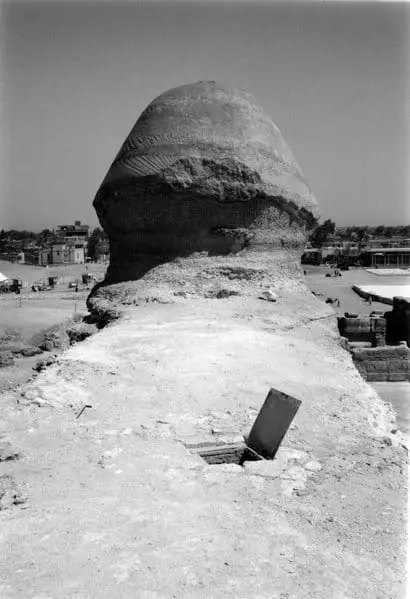
It was initially unearthed by the renowned archaeologist Auguste Mariette back in 1853. Before being restored, it was a fairly large crack, opening up to about 2 meters (or 6.6 feet) wide at the Sphinx’s topmost back.
When the 1920s rolled around, Emile Baraize, a French engineer and a big name in Sphinx restoration, reinforced this fissure. He fortified the sides of the fissure and overlaid it with iron bars, limestone, and cement, effectively roofing the crevice. An iron trap door was also installed at the entrance to provide future access to the depths of the crack.
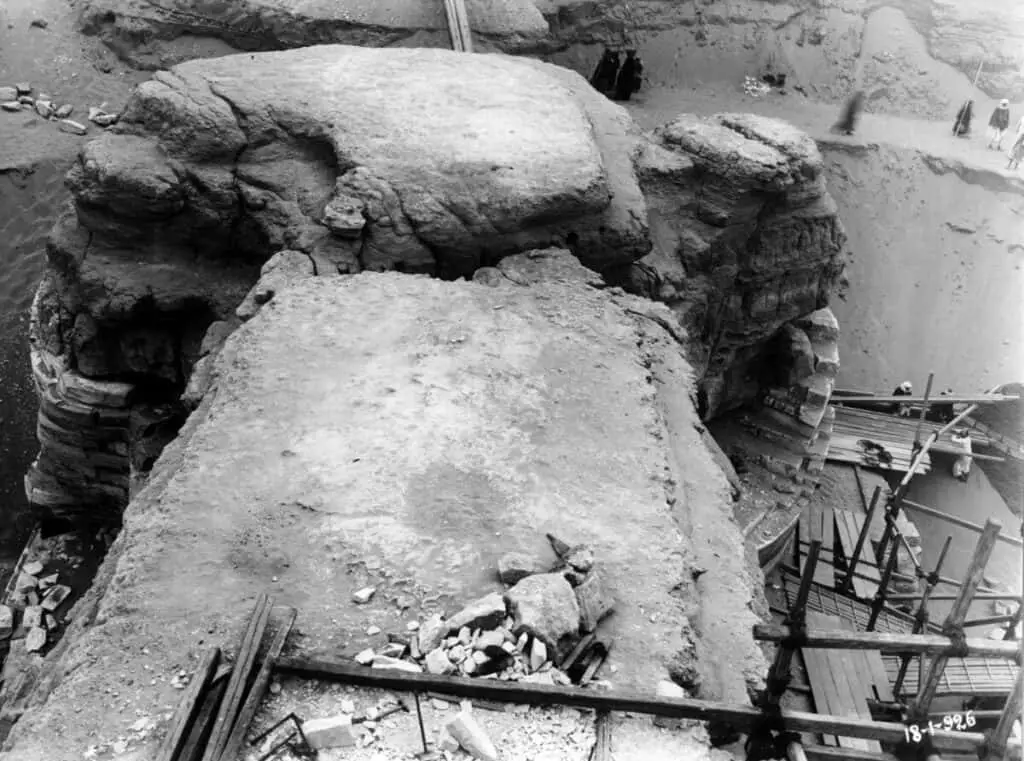
It’s believed that treasure seekers of the past chiseled out this 3.2-meter-deep hole. However, the shaft doesn’t lead to any treasure or secret chambers
—it’s a dead-end shaft.
6. The Rump Shaft “Shaft D”
In 1926, the Great Sphinx underwent a significant clearing procedure directed by Baraize, revealing a tunnel entrance at the monument’s rear (northern flank). Restoration efforts eventually hid this passage, making its existence obscured for decades.
Fast forward a half a century later, Mohammed Abd al-Mawgud Fayed, a former worker in the 1926 clearing operation, brought this forgotten passage back into memory.
Sparked by Mohammed’s revelation, a fresh exploration started in 1980, spearheaded by Dr. Hawass and renowned Egyptologist Mark Lerner.
This rediscovered passage was named Shaft D.
Located under the rear hinds, shaft D burrows into the Sphinx, spiraling downward until it hits a dead end about 4.5 meters beneath the floor level, ultimately reaching the water table.
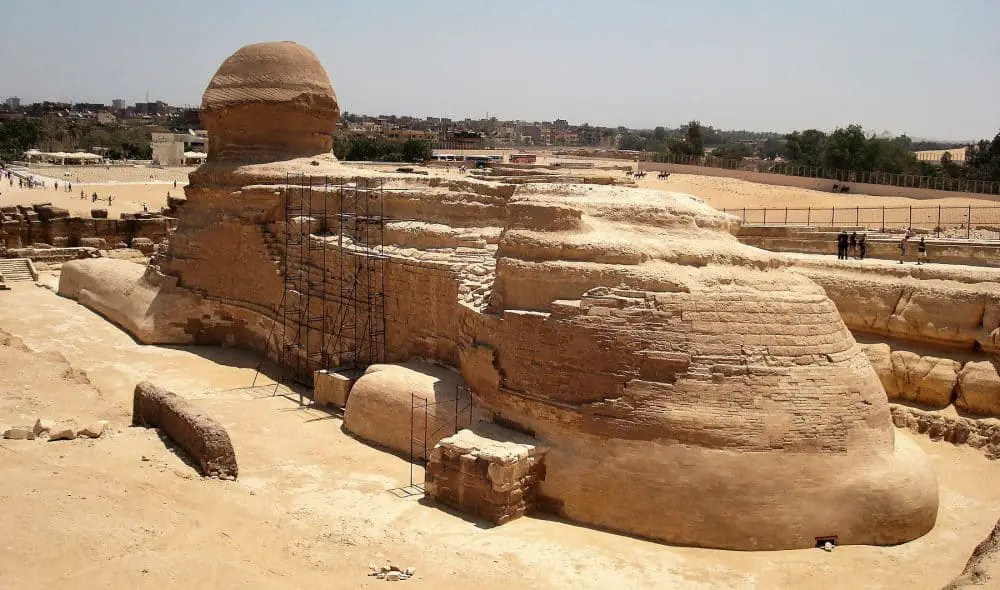
Shaft D comprises two parts, angled about 90 degrees from each other:
- The upper section, approximately 4 meters above the ground, wedges into a northwest direction between the Sphinx’s core and its masonry veneer. It culminates in a 1-meter niche topped with modern cement that seemingly seeped from an overhead gap.
- The lower section takes a northeast plunge into the bedrock. Measuring around 4 meters in distance and 5 meters deep, it ends at a dead end pit at groundwater level. Starting at a width of 1.3 meters, the passage narrows towards the dead end, where remnants of modern artifacts like tin foil and a ceramic jar base were found, indicating more recent human activities.
The rough-hewn nature of the passage, uneven sides, and the presence of foot-holds, indicate its exploratory intent rather than serving any definitive purpose, thereby adding another layer of mystery as to its original purpose.
7. The Key-Hole Shaft
The “keyhole” shaft is located under the northern ledge near the Sphinx’s north hind paw and is technically part of the more extensive “Shaft D”.
The square shaft, measuring roughly 4.5 feet wide, 3.5 feet long, and just over 6 feet deep, was discovered during Hawass’s 1978 excavation.
This intriguing space is believed to have served as an unfinished tomb, based on the interpretation of American Egyptologist Dr. Mark Lehner. His perspective led to its naming as the “Keyhole Shaft,” a name inspired by cuttings above the shaft that resembled an inverted Victorian-era keyhole.
A large piece of basalt with a smooth surface, discovered within the shaft, suggests the intended function of this structure as a tomb.
The shaft’s relatively pristine state, devoid of modern inclusions, indicates it may have escaped attention during previous excavations.
The Hall of Records: Myth or Reality?
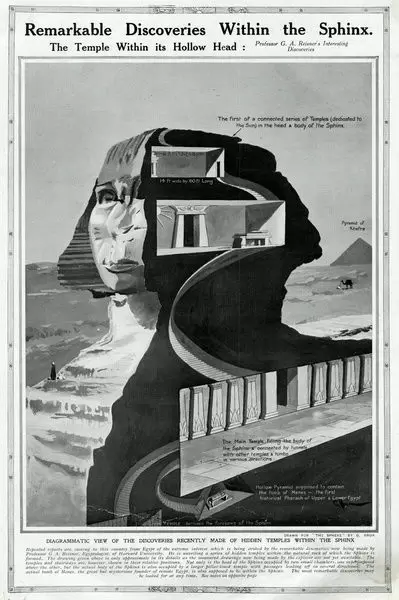
The Hall of Records, as told in legends, is a hidden repository of ancient wisdom located somewhere in Egypt.
French author Jean-Baptiste Pitois, under his pen name Paul Christian, suggested in his 1870 book that the Sphinx was the entrance to secret chambers.
According to Egyptian tradition, the god Thoth inscribed celestial secrets into sacred books and concealed them within this mysterious Hall. It is said to hold not only ancient Egyptian wisdom but also records of an ancient Atlantean civilization, and secrets to the universe.
The Hall of Records has fascinated Egyptologists for centuries, seen as a significant discovery that could reshape our understanding of ancient history, particularly the origins of Ancient Egyptian civilization.
Some proponents suggest its existence based on scientific indicators of hidden chambers beneath the Sphinx. However, excavations have failed to provide concrete evidence supporting its presence.
The topic remains controversial, with skeptics dismissing it as pseudo-archaeology while others maintain the possibility of its existence. However, it’s crucial to approach these claims with critical thinking and scientific scrutiny.
Description of Edgar Cayce’s prophecies about the Hall of Records
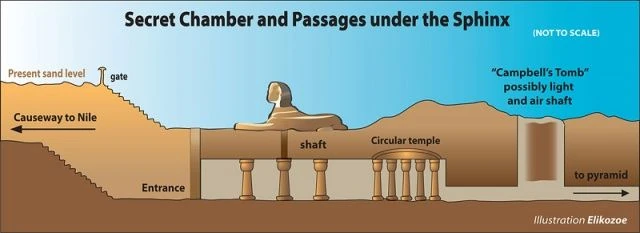
Edgar Cayce, known as the “Sleeping Prophet,” popularized the concept of the Hall of Records through his trance readings.
Edgar Cayce (1877-1945) was a prominent figure in America in the late 1800’s and early 1900’s.
Cayce was known for entering a sleep-like trance state where he could access the universal consciousness. During these trances, he provided thousands of readings to individuals seeking guidance. His readings covered a wide range of topics and offered practical advice to people.
He emphasized the significance of personal spiritual development and encouraged individuals to align themselves with higher spiritual principles.
Cayce stated in some of his trances that Egypt was the repository for records of the alleged civilization of Atlantis, about 10,500 B.C. This repository was an underground library, called the Hall of Records,” that contained the wisdom of Atlantis.
Cayce claims that the Sphinx points in the direction of the “Hall of Records.” His reading states:
“There is a chamber or passage from the right forepaw of the [Sphinx] to this entrance of the Hall of records, or chamber.”
Despite Cayce’s prophecies and subsequent research efforts, including sophisticated instruments, no concrete evidence of the Hall of Records has been found.
Supporters of Cayce maintain that his readings validate the existence of the Hall of Records, while skeptics emphasize the lack of tangible findings.
Overall, the search for the Hall of Records beneath the Sphinx remains inconclusive, leaving the true nature and significance of this supposed repository shrouded in uncertainty.
Also according to Edgar Cayce there may be more then one “Hall of Records”, hidden in other locations on Earth.
One below miles of sea slime in a temple of the sunken island Poseidia, one in the Yucatán Peninsula in Mexico, and one in Tibet. Trance clairvoyant Dr. Douglas James Cottrell also mentioned another undiscovered repository of ancient knowledge below the temple complex of Angkor Wat in Cambodia.
Archaeological Evidence for the Hall of Records
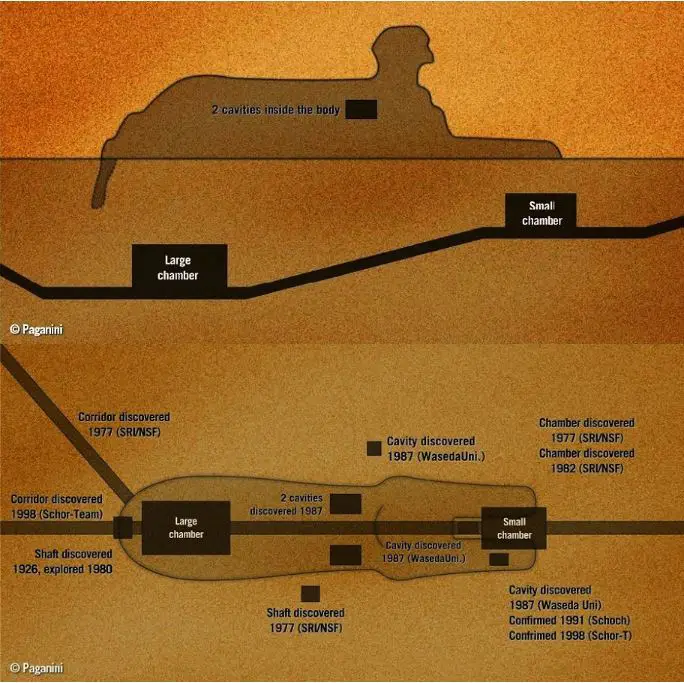
1. SRI International Survey – 1977
In 1977, SRI International conducted an electrical resistivity and acoustical survey at the Sphinx. Their research aimed to understand the bedrock under and around the Sphinx.
According to Physicist, Lambert Dolphin…”In 1978, my colleagues and I (from SRI International), as part of a grant from the Edgar Cayce Foundation, performed a closely-spaced resistivity survey all around the Sphinx. We then performed high-frequency seismic sounding over the entire platform and in front.
Their findings suggested that the area remains undisturbed bedrock.
2. Waseda University Survey – 1987
In 1987, a Japanese team from Waseda University conducted an electromagnetic sounding survey of the Khufu Pyramid and with ground-penetrating radar the “Sanctuary of the Sphinx.”
Their survey revealed the presence of a north-south tunnel under the Sphinx, a water pocket near the south hind paw, and another cavity near the north hind paw.
North of the Sphinx, they found another groove similar to the southern one which may indicate a tunnel underneath the Sphinx connecting the south and north grooves. In front of the two paws of the Sphinx, another hollow space was found one to two meters below the surface that also may extend underneath the Sphinx.
This work was confirmed and incorporated into the film, “The Mystery of the Sphinx” made in 1992-1993
3. Dr. Robert Schoch, Dr. Thomas Dobecki, and John Anthony West
In 1991, geologists Robert Schoch, Thomas Dobecki, and John Anthony West performed a seismic survey of the Sphinx. They also observed different weathering patterns, suggesting that the Sphinx’s creation occurred around 12,000 BC, challenging the commonly accepted age of 4,500 years.
In 1992-1993, another team involving John Anthony West, Robert M. Schoch, and Thomas Dobecki used ground-penetrating radar (GPR), finding indications of voids near the Sphinx’s front paws and rear flanks. The surveys hinted at unexplored tunnels and a rectangular chamber about 25 feet beneath the monument’s front paws.
However, further verification of these claims reportedly faced obstacles imposed by the Egyptian government.
4. Egyptian National Research Institute of Astronomy and Geophysics
In 1992, Imam Marzouk and Ali Gharib from the Egyptian National Research Institute of Astronomy and Geophysics conducted a shallow seismic refraction study. Their investigation provided insights into the composition of the subsurface rock composition.
5. Florida State University
In April, 1996, Egypt’s Supreme Council of Antiquities (S.C.A.) granted a one-year license to a team academically sponsored by Florida State University and financially sponsored by the Schor Foundation to conduct surveys around the Sphinx and the Giza necropolis using seismic equipment and ground-penetrating radar.
However, the details of their findings remain undisclosed, and further verification is necessary.
Dr. Daniel Pullen, an Associate Professor of Classics and archaeologist, shared insights into the explorations conducted by a team from Florida State University (FSU) at the Giza Plateau in April 1996.
The purpose of their expedition, which included three geologists and one archaeologist, was to investigate controversies surrounding the weathering, dating, and construction of the Sphinx as well as other monuments.
Using radar technology during their survey, the team made significant findings. They discovered a tunnel approximately 40 feet below the rump of the Great Sphinx. Additionally, they verified the potential existence of a large rectangular chamber beneath the Sphinx’s front paws, which had initially been detected by the John West/Dr. Schoch expedition from 1991 to 1993.
Dr. Schor, an FSU alumnus and representative of the Schor Foundation, strongly argues that the radar survey provides evidence supporting the presence of an underground network of tunnels and chambers surrounding the Sphinx.
The Florida State team consisted of esteemed professionals: Dr. Alan Zindler, Chair of Geology and head of geochemistry at the National High Magnetic Field Laboratory; Dr. Leroy Odom, a Professor of Geology and geochemist at NHMFL; Dr. James Tull, a Professor of Geology and structural geologist; and Dr. Daniel Pullen, an Associate Professor of Classics and archaeologist.
6. The Schor Foundation
In August 2001, the Schor Foundation sponsored a ground-penetrating radar survey near the left front paw of the Sphinx enclosure.
By employing 250 MHz antennas, the team collected 15 profiles and applied advanced filters and processing techniques to generate a 3D image. The image showcased two parallel surfaces sloping downward beneath the paw, raising the possibility of either a man-made structure or natural fractures in the bedrock.
The two surfaces in the image could be interpreted as indicating a man‐made structure leading down beneath the Sphinx.
Such features could also caused by natural fractures in the underlying limestone bedrock, but the fractures would have to be relatively wide.
All of these archaeological investigations have provided intriguing clues regarding potential chambers and tunnels beneath the Sphinx, contributing to the ongoing quest to uncover the Hall of Records.
However, due to various challenges and limitations, further exploration and substantiation of these claims have encountered obstacles, leaving the true nature and existence of the Hall of Records unresolved.
The Future of Exploration: What’s Next for the Sphinx?
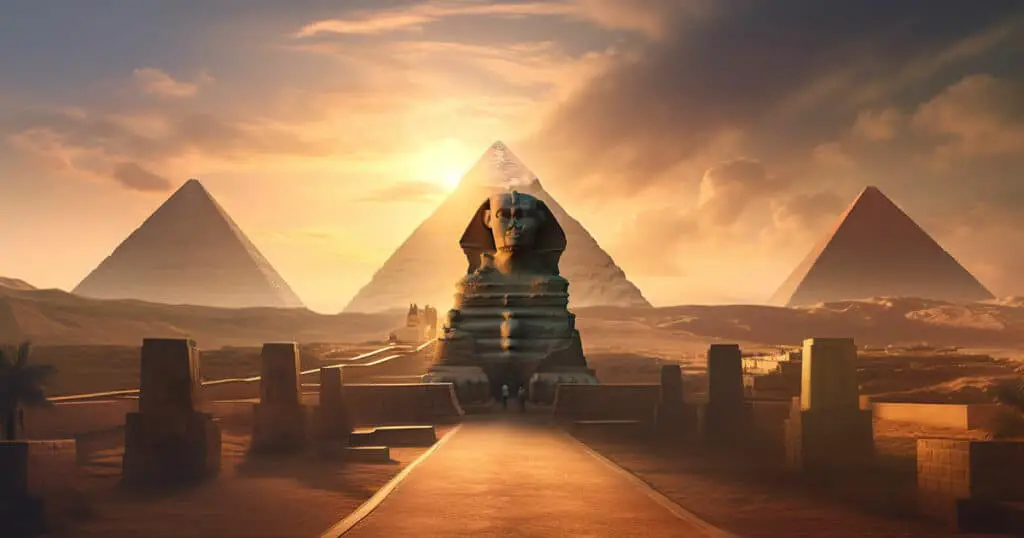
The future of Sphinx exploration is uncertain, with obstacles like political resistance and limited excavations hindering progress.
While speculation persists, concrete evidence is yet to be found. Dr. Hawass emphasizes the need for data-driven plans and ongoing studies for preservation.
In 2009, laser scanning provided a precise 3-D model of the Sphinx, aiding restoration efforts. The release of the ARCE Sphinx Project in 2018 offered insights into its origins and construction techniques, while setting the stage for future restoration work.
The search for the Hall of Records and hidden chambers continues, but the outcomes depend on factors like funding, technology, and stakeholder support.
Final Thoughts: What’s Under The Sphinx …
The mysteries surrounding the Sphinx and the search for the Hall of Records continue to captivate researchers and enthusiasts. While evidence and scientific investigations have provided intriguing clues, concrete proof of hidden chambers remains elusive.
The age and construction of the Sphinx itself are subjects of debate, challenging conventional beliefs and opening doors to alternative theories.
The future of Sphinx exploration hinges on various factors, including political and cultural contexts, technological advancements, and funding availability.
Preservation efforts, ongoing studies, and restoration projects contribute to our understanding of the Sphinx’s origins and offer glimpses into the ancient world.
As we look ahead, the quest for the Hall of Records and the unraveling of ancient Egyptian secrets remain a fascinating journey that continues to intrigue and inspire.
Loved what you read?
Hit that share button and let the world in on the secret – we’d be thrilled!
Got thoughts? We’re all ears for your feedback, corrections, or a good old chat. Don’t be shy; drop us a line.
And hey, don’t miss out on our curated list of must-reads in the recommended books section.
Big thanks for diving in with us today!


